Dissertation: COBIT 5 Framework Implementation for RFA IT Governance
VerifiedAdded on 2022/11/13
|13
|2786
|183
Project
AI Summary
This dissertation proposal outlines a study investigating the implementation of the COBIT 5 framework as a mechanism for IT governance within the Road Fund Administration (RFA) in Namibia. The research aims to evaluate the effectiveness of COBIT 5 compared to the RFA's current IT governance framework, standards, and processes. The study will address key research questions, including the effectiveness of the current IT governance framework, the potential benefits of implementing COBIT 5, and the alignment of IT governance with business objectives. The proposal includes a literature review of COBIT 5 principles, the RFA's strategic business plan, and the need for a robust IT governance framework. The methodology section details the use of qualitative research methods, secondary data analysis, and ethical considerations. The study is limited by time and budget constraints, and the research will be conducted in a cross-sectional manner. The goal is to provide valuable insights into enhancing IT governance practices within the RFA, contributing to improved IT decision-making and alignment with business goals.
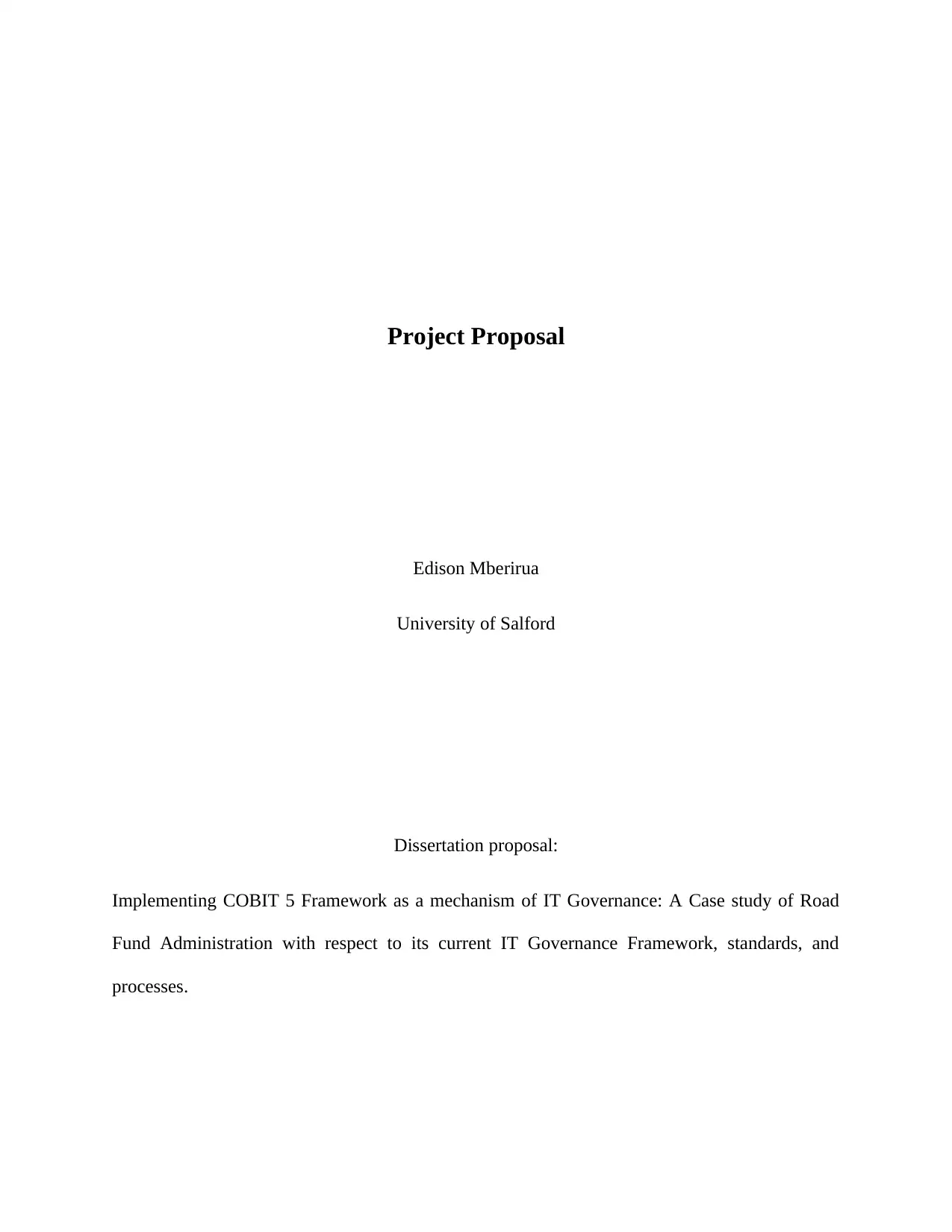
Project Proposal
Edison Mberirua
University of Salford
Dissertation proposal:
Implementing COBIT 5 Framework as a mechanism of IT Governance: A Case study of Road
Fund Administration with respect to its current IT Governance Framework, standards, and
processes.
Edison Mberirua
University of Salford
Dissertation proposal:
Implementing COBIT 5 Framework as a mechanism of IT Governance: A Case study of Road
Fund Administration with respect to its current IT Governance Framework, standards, and
processes.
Paraphrase This Document
Need a fresh take? Get an instant paraphrase of this document with our AI Paraphraser
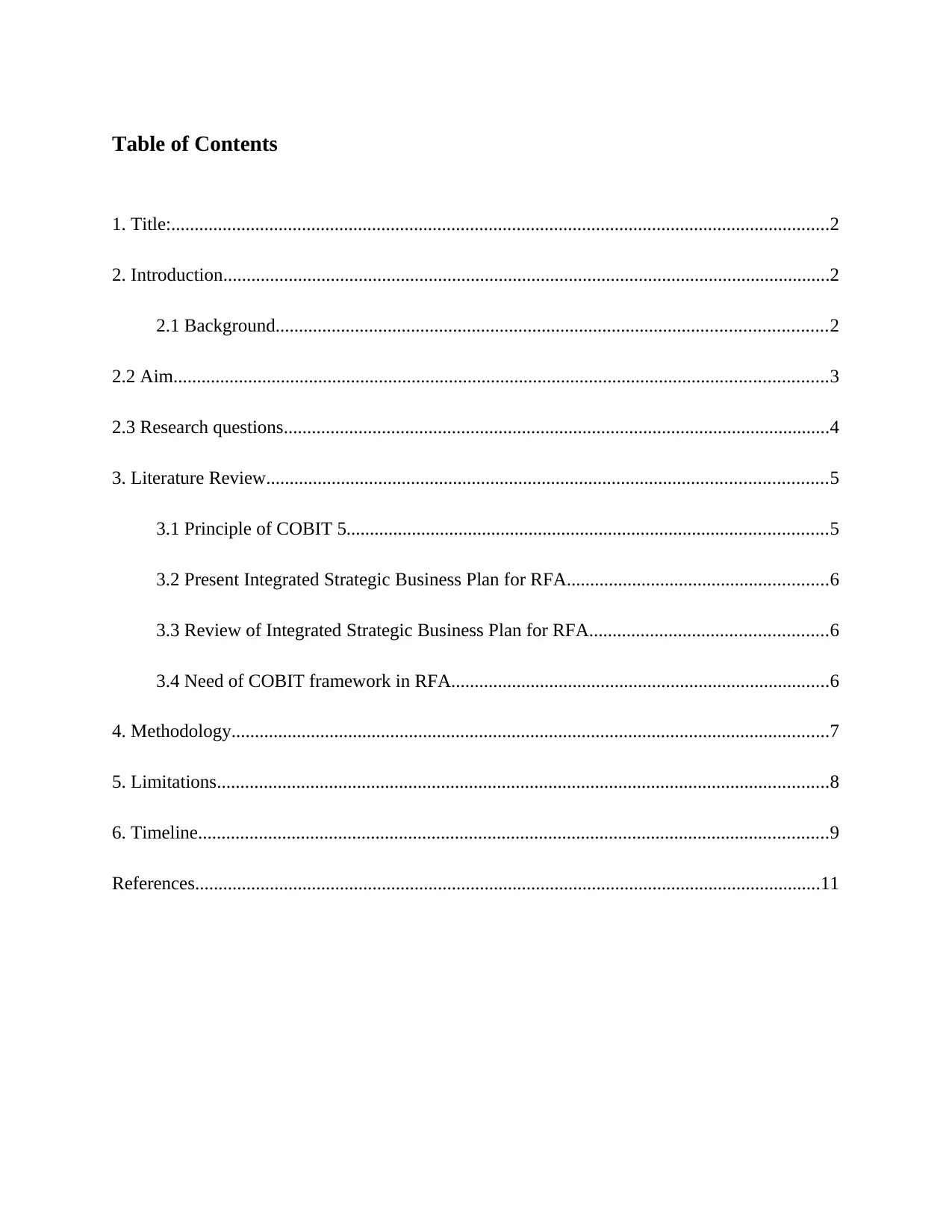
Table of Contents
1. Title:.............................................................................................................................................2
2. Introduction..................................................................................................................................2
2.1 Background......................................................................................................................2
2.2 Aim............................................................................................................................................3
2.3 Research questions.....................................................................................................................4
3. Literature Review........................................................................................................................5
3.1 Principle of COBIT 5.......................................................................................................5
3.2 Present Integrated Strategic Business Plan for RFA........................................................6
3.3 Review of Integrated Strategic Business Plan for RFA...................................................6
3.4 Need of COBIT framework in RFA.................................................................................6
4. Methodology................................................................................................................................7
5. Limitations...................................................................................................................................8
6. Timeline.......................................................................................................................................9
References......................................................................................................................................11
1. Title:.............................................................................................................................................2
2. Introduction..................................................................................................................................2
2.1 Background......................................................................................................................2
2.2 Aim............................................................................................................................................3
2.3 Research questions.....................................................................................................................4
3. Literature Review........................................................................................................................5
3.1 Principle of COBIT 5.......................................................................................................5
3.2 Present Integrated Strategic Business Plan for RFA........................................................6
3.3 Review of Integrated Strategic Business Plan for RFA...................................................6
3.4 Need of COBIT framework in RFA.................................................................................6
4. Methodology................................................................................................................................7
5. Limitations...................................................................................................................................8
6. Timeline.......................................................................................................................................9
References......................................................................................................................................11
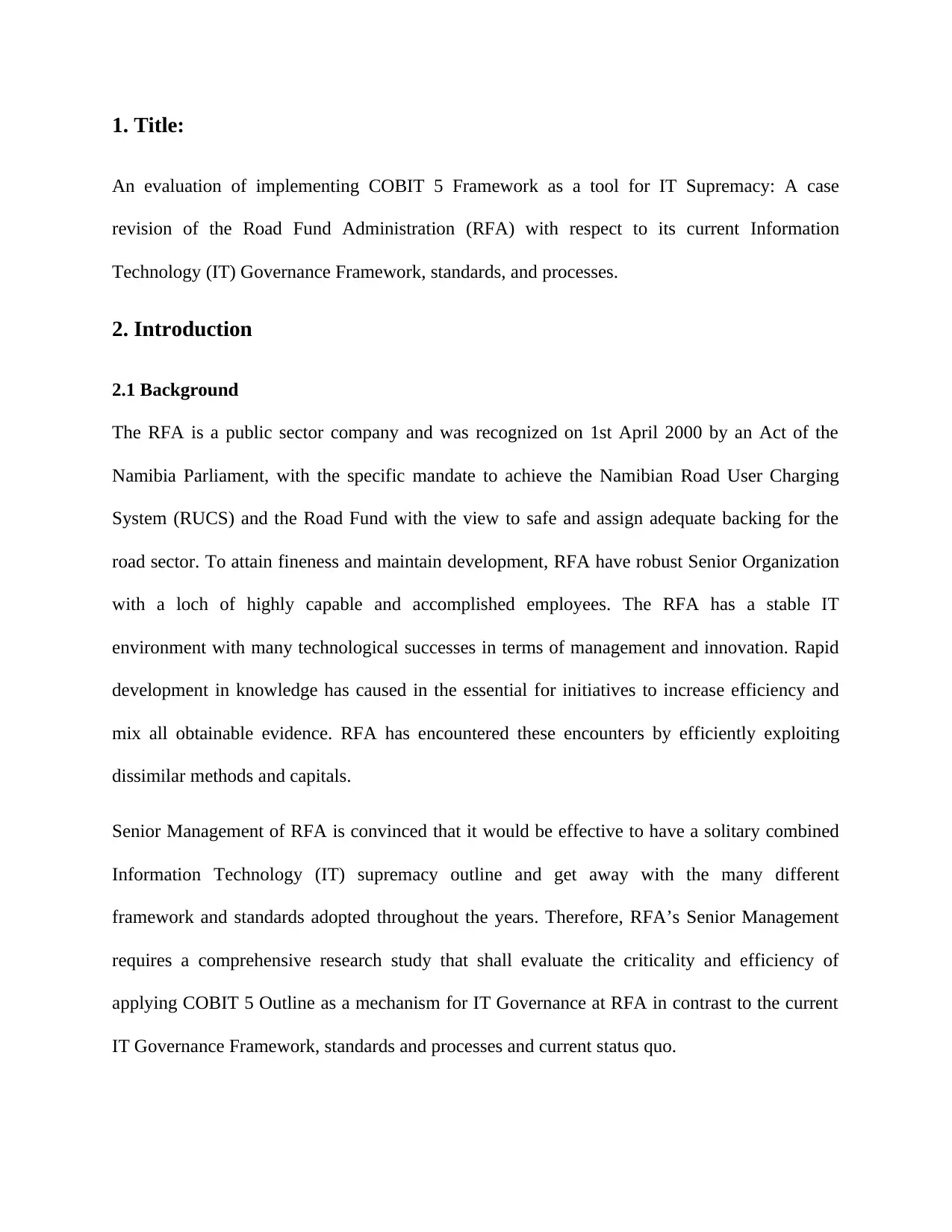
1. Title:
An evaluation of implementing COBIT 5 Framework as a tool for IT Supremacy: A case
revision of the Road Fund Administration (RFA) with respect to its current Information
Technology (IT) Governance Framework, standards, and processes.
2. Introduction
2.1 Background
The RFA is a public sector company and was recognized on 1st April 2000 by an Act of the
Namibia Parliament, with the specific mandate to achieve the Namibian Road User Charging
System (RUCS) and the Road Fund with the view to safe and assign adequate backing for the
road sector. To attain fineness and maintain development, RFA have robust Senior Organization
with a loch of highly capable and accomplished employees. The RFA has a stable IT
environment with many technological successes in terms of management and innovation. Rapid
development in knowledge has caused in the essential for initiatives to increase efficiency and
mix all obtainable evidence. RFA has encountered these encounters by efficiently exploiting
dissimilar methods and capitals.
Senior Management of RFA is convinced that it would be effective to have a solitary combined
Information Technology (IT) supremacy outline and get away with the many different
framework and standards adopted throughout the years. Therefore, RFA’s Senior Management
requires a comprehensive research study that shall evaluate the criticality and efficiency of
applying COBIT 5 Outline as a mechanism for IT Governance at RFA in contrast to the current
IT Governance Framework, standards and processes and current status quo.
An evaluation of implementing COBIT 5 Framework as a tool for IT Supremacy: A case
revision of the Road Fund Administration (RFA) with respect to its current Information
Technology (IT) Governance Framework, standards, and processes.
2. Introduction
2.1 Background
The RFA is a public sector company and was recognized on 1st April 2000 by an Act of the
Namibia Parliament, with the specific mandate to achieve the Namibian Road User Charging
System (RUCS) and the Road Fund with the view to safe and assign adequate backing for the
road sector. To attain fineness and maintain development, RFA have robust Senior Organization
with a loch of highly capable and accomplished employees. The RFA has a stable IT
environment with many technological successes in terms of management and innovation. Rapid
development in knowledge has caused in the essential for initiatives to increase efficiency and
mix all obtainable evidence. RFA has encountered these encounters by efficiently exploiting
dissimilar methods and capitals.
Senior Management of RFA is convinced that it would be effective to have a solitary combined
Information Technology (IT) supremacy outline and get away with the many different
framework and standards adopted throughout the years. Therefore, RFA’s Senior Management
requires a comprehensive research study that shall evaluate the criticality and efficiency of
applying COBIT 5 Outline as a mechanism for IT Governance at RFA in contrast to the current
IT Governance Framework, standards and processes and current status quo.
⊘ This is a preview!⊘
Do you want full access?
Subscribe today to unlock all pages.

Trusted by 1+ million students worldwide
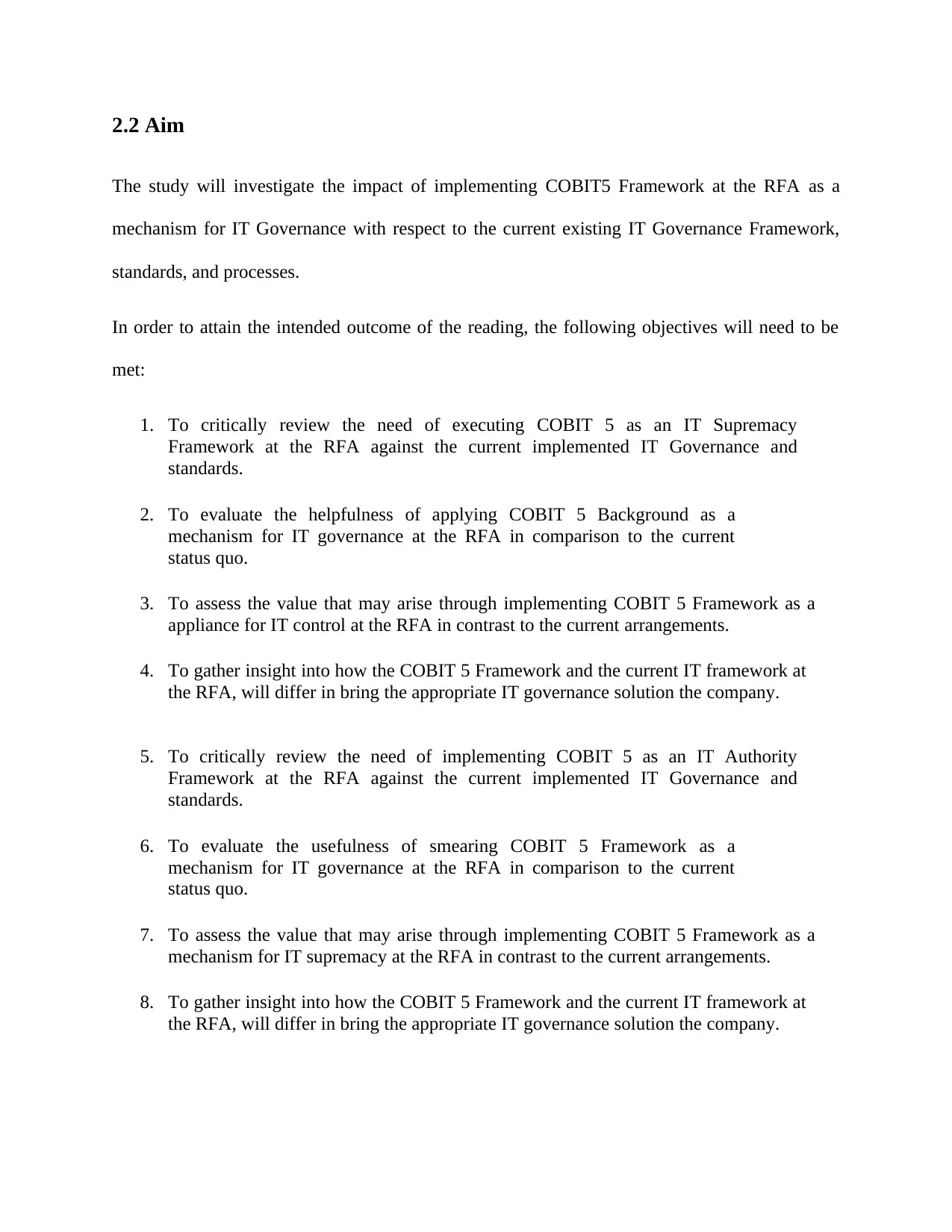
2.2 Aim
The study will investigate the impact of implementing COBIT5 Framework at the RFA as a
mechanism for IT Governance with respect to the current existing IT Governance Framework,
standards, and processes.
In order to attain the intended outcome of the reading, the following objectives will need to be
met:
1. To critically review the need of executing COBIT 5 as an IT Supremacy
Framework at the RFA against the current implemented IT Governance and
standards.
2. To evaluate the helpfulness of applying COBIT 5 Background as a
mechanism for IT governance at the RFA in comparison to the current
status quo.
3. To assess the value that may arise through implementing COBIT 5 Framework as a
appliance for IT control at the RFA in contrast to the current arrangements.
4. To gather insight into how the COBIT 5 Framework and the current IT framework at
the RFA, will differ in bring the appropriate IT governance solution the company.
5. To critically review the need of implementing COBIT 5 as an IT Authority
Framework at the RFA against the current implemented IT Governance and
standards.
6. To evaluate the usefulness of smearing COBIT 5 Framework as a
mechanism for IT governance at the RFA in comparison to the current
status quo.
7. To assess the value that may arise through implementing COBIT 5 Framework as a
mechanism for IT supremacy at the RFA in contrast to the current arrangements.
8. To gather insight into how the COBIT 5 Framework and the current IT framework at
the RFA, will differ in bring the appropriate IT governance solution the company.
The study will investigate the impact of implementing COBIT5 Framework at the RFA as a
mechanism for IT Governance with respect to the current existing IT Governance Framework,
standards, and processes.
In order to attain the intended outcome of the reading, the following objectives will need to be
met:
1. To critically review the need of executing COBIT 5 as an IT Supremacy
Framework at the RFA against the current implemented IT Governance and
standards.
2. To evaluate the helpfulness of applying COBIT 5 Background as a
mechanism for IT governance at the RFA in comparison to the current
status quo.
3. To assess the value that may arise through implementing COBIT 5 Framework as a
appliance for IT control at the RFA in contrast to the current arrangements.
4. To gather insight into how the COBIT 5 Framework and the current IT framework at
the RFA, will differ in bring the appropriate IT governance solution the company.
5. To critically review the need of implementing COBIT 5 as an IT Authority
Framework at the RFA against the current implemented IT Governance and
standards.
6. To evaluate the usefulness of smearing COBIT 5 Framework as a
mechanism for IT governance at the RFA in comparison to the current
status quo.
7. To assess the value that may arise through implementing COBIT 5 Framework as a
mechanism for IT supremacy at the RFA in contrast to the current arrangements.
8. To gather insight into how the COBIT 5 Framework and the current IT framework at
the RFA, will differ in bring the appropriate IT governance solution the company.
Paraphrase This Document
Need a fresh take? Get an instant paraphrase of this document with our AI Paraphraser
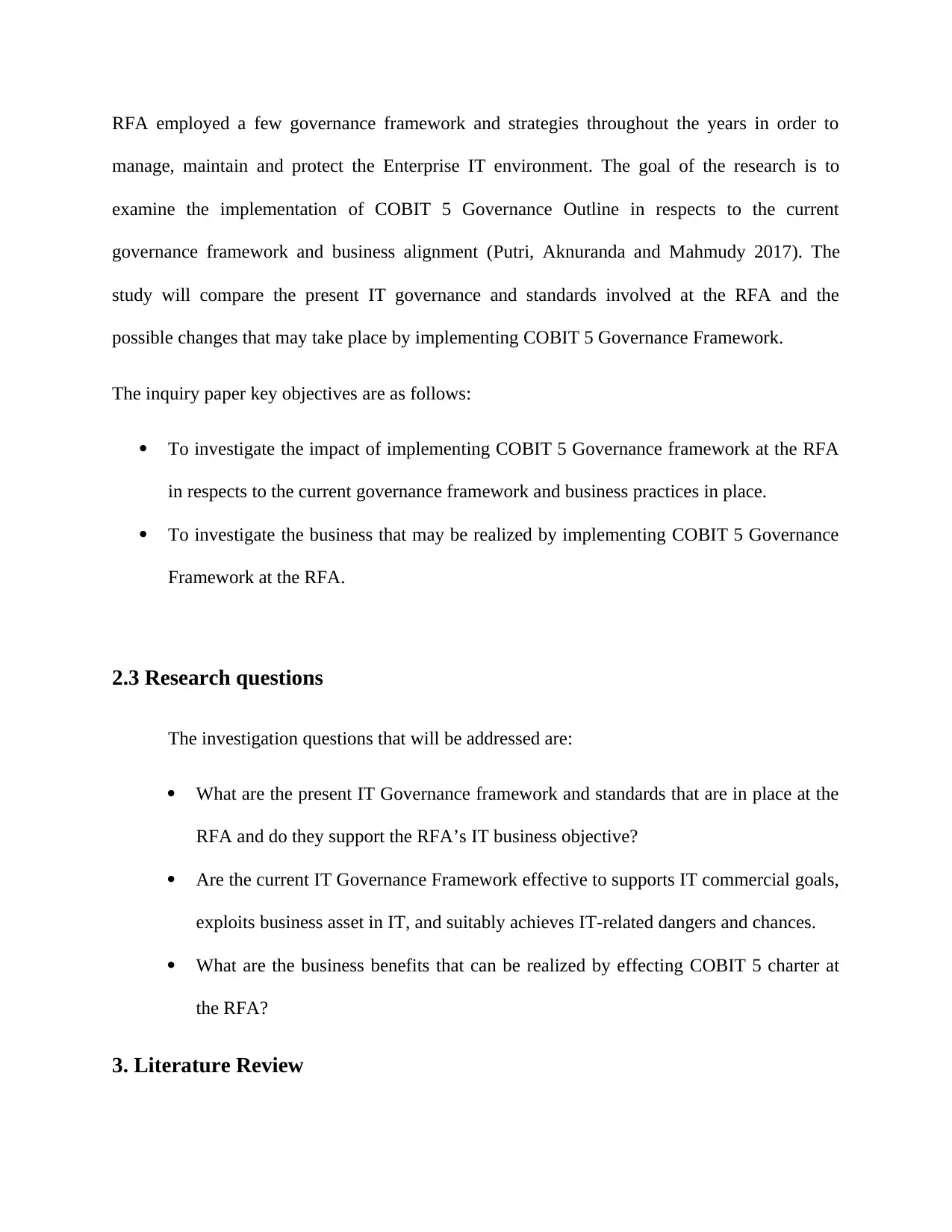
RFA employed a few governance framework and strategies throughout the years in order to
manage, maintain and protect the Enterprise IT environment. The goal of the research is to
examine the implementation of COBIT 5 Governance Outline in respects to the current
governance framework and business alignment (Putri, Aknuranda and Mahmudy 2017). The
study will compare the present IT governance and standards involved at the RFA and the
possible changes that may take place by implementing COBIT 5 Governance Framework.
The inquiry paper key objectives are as follows:
To investigate the impact of implementing COBIT 5 Governance framework at the RFA
in respects to the current governance framework and business practices in place.
To investigate the business that may be realized by implementing COBIT 5 Governance
Framework at the RFA.
2.3 Research questions
The investigation questions that will be addressed are:
What are the present IT Governance framework and standards that are in place at the
RFA and do they support the RFA’s IT business objective?
Are the current IT Governance Framework effective to supports IT commercial goals,
exploits business asset in IT, and suitably achieves IT-related dangers and chances.
What are the business benefits that can be realized by effecting COBIT 5 charter at
the RFA?
3. Literature Review
manage, maintain and protect the Enterprise IT environment. The goal of the research is to
examine the implementation of COBIT 5 Governance Outline in respects to the current
governance framework and business alignment (Putri, Aknuranda and Mahmudy 2017). The
study will compare the present IT governance and standards involved at the RFA and the
possible changes that may take place by implementing COBIT 5 Governance Framework.
The inquiry paper key objectives are as follows:
To investigate the impact of implementing COBIT 5 Governance framework at the RFA
in respects to the current governance framework and business practices in place.
To investigate the business that may be realized by implementing COBIT 5 Governance
Framework at the RFA.
2.3 Research questions
The investigation questions that will be addressed are:
What are the present IT Governance framework and standards that are in place at the
RFA and do they support the RFA’s IT business objective?
Are the current IT Governance Framework effective to supports IT commercial goals,
exploits business asset in IT, and suitably achieves IT-related dangers and chances.
What are the business benefits that can be realized by effecting COBIT 5 charter at
the RFA?
3. Literature Review

3.1 Principle of COBIT 5
As stated by Mostafa 2018, there are five principles that are associated with COBIT 5. These
principles are important for effective management as well as effective governance in RFA
organization. The principles states that:
Principle 1: Need of meeting the stakeholders
Principle 2: End to end covering of enterprise
Principle 3: Apply some integrated framework
Principle 4: Enable an approach known as holistic approach
Principle 5: Separating the governance from the management
Sabatini, Setyohadi and Purnomo, (2017) stated that the above mentioned principles helps an
organization to enable or build some holistic framework for governing as well as managing the
processes of IT built on below stated seven enablers.
1. Frameworks, policies, and people
2. Processes
3. The structure of the organizations
4. The culture, behavior and the ethics followed
5. Information
6. The applications, infrastructures and the services involved
7. The competencies, skills, and the people
As stated by Mostafa 2018, there are five principles that are associated with COBIT 5. These
principles are important for effective management as well as effective governance in RFA
organization. The principles states that:
Principle 1: Need of meeting the stakeholders
Principle 2: End to end covering of enterprise
Principle 3: Apply some integrated framework
Principle 4: Enable an approach known as holistic approach
Principle 5: Separating the governance from the management
Sabatini, Setyohadi and Purnomo, (2017) stated that the above mentioned principles helps an
organization to enable or build some holistic framework for governing as well as managing the
processes of IT built on below stated seven enablers.
1. Frameworks, policies, and people
2. Processes
3. The structure of the organizations
4. The culture, behavior and the ethics followed
5. Information
6. The applications, infrastructures and the services involved
7. The competencies, skills, and the people
⊘ This is a preview!⊘
Do you want full access?
Subscribe today to unlock all pages.

Trusted by 1+ million students worldwide
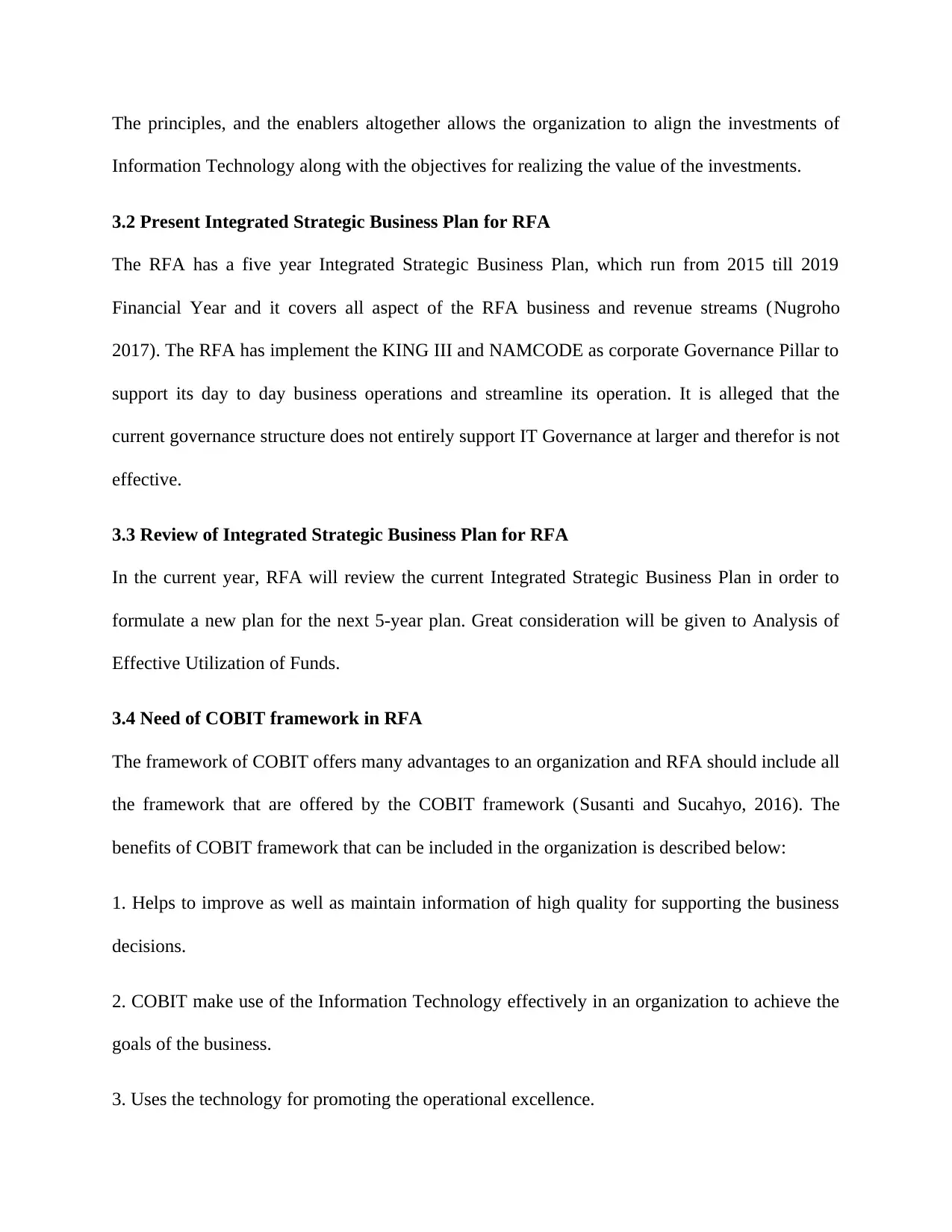
The principles, and the enablers altogether allows the organization to align the investments of
Information Technology along with the objectives for realizing the value of the investments.
3.2 Present Integrated Strategic Business Plan for RFA
The RFA has a five year Integrated Strategic Business Plan, which run from 2015 till 2019
Financial Year and it covers all aspect of the RFA business and revenue streams (Nugroho
2017). The RFA has implement the KING III and NAMCODE as corporate Governance Pillar to
support its day to day business operations and streamline its operation. It is alleged that the
current governance structure does not entirely support IT Governance at larger and therefor is not
effective.
3.3 Review of Integrated Strategic Business Plan for RFA
In the current year, RFA will review the current Integrated Strategic Business Plan in order to
formulate a new plan for the next 5-year plan. Great consideration will be given to Analysis of
Effective Utilization of Funds.
3.4 Need of COBIT framework in RFA
The framework of COBIT offers many advantages to an organization and RFA should include all
the framework that are offered by the COBIT framework (Susanti and Sucahyo, 2016). The
benefits of COBIT framework that can be included in the organization is described below:
1. Helps to improve as well as maintain information of high quality for supporting the business
decisions.
2. COBIT make use of the Information Technology effectively in an organization to achieve the
goals of the business.
3. Uses the technology for promoting the operational excellence.
Information Technology along with the objectives for realizing the value of the investments.
3.2 Present Integrated Strategic Business Plan for RFA
The RFA has a five year Integrated Strategic Business Plan, which run from 2015 till 2019
Financial Year and it covers all aspect of the RFA business and revenue streams (Nugroho
2017). The RFA has implement the KING III and NAMCODE as corporate Governance Pillar to
support its day to day business operations and streamline its operation. It is alleged that the
current governance structure does not entirely support IT Governance at larger and therefor is not
effective.
3.3 Review of Integrated Strategic Business Plan for RFA
In the current year, RFA will review the current Integrated Strategic Business Plan in order to
formulate a new plan for the next 5-year plan. Great consideration will be given to Analysis of
Effective Utilization of Funds.
3.4 Need of COBIT framework in RFA
The framework of COBIT offers many advantages to an organization and RFA should include all
the framework that are offered by the COBIT framework (Susanti and Sucahyo, 2016). The
benefits of COBIT framework that can be included in the organization is described below:
1. Helps to improve as well as maintain information of high quality for supporting the business
decisions.
2. COBIT make use of the Information Technology effectively in an organization to achieve the
goals of the business.
3. Uses the technology for promoting the operational excellence.
Paraphrase This Document
Need a fresh take? Get an instant paraphrase of this document with our AI Paraphraser
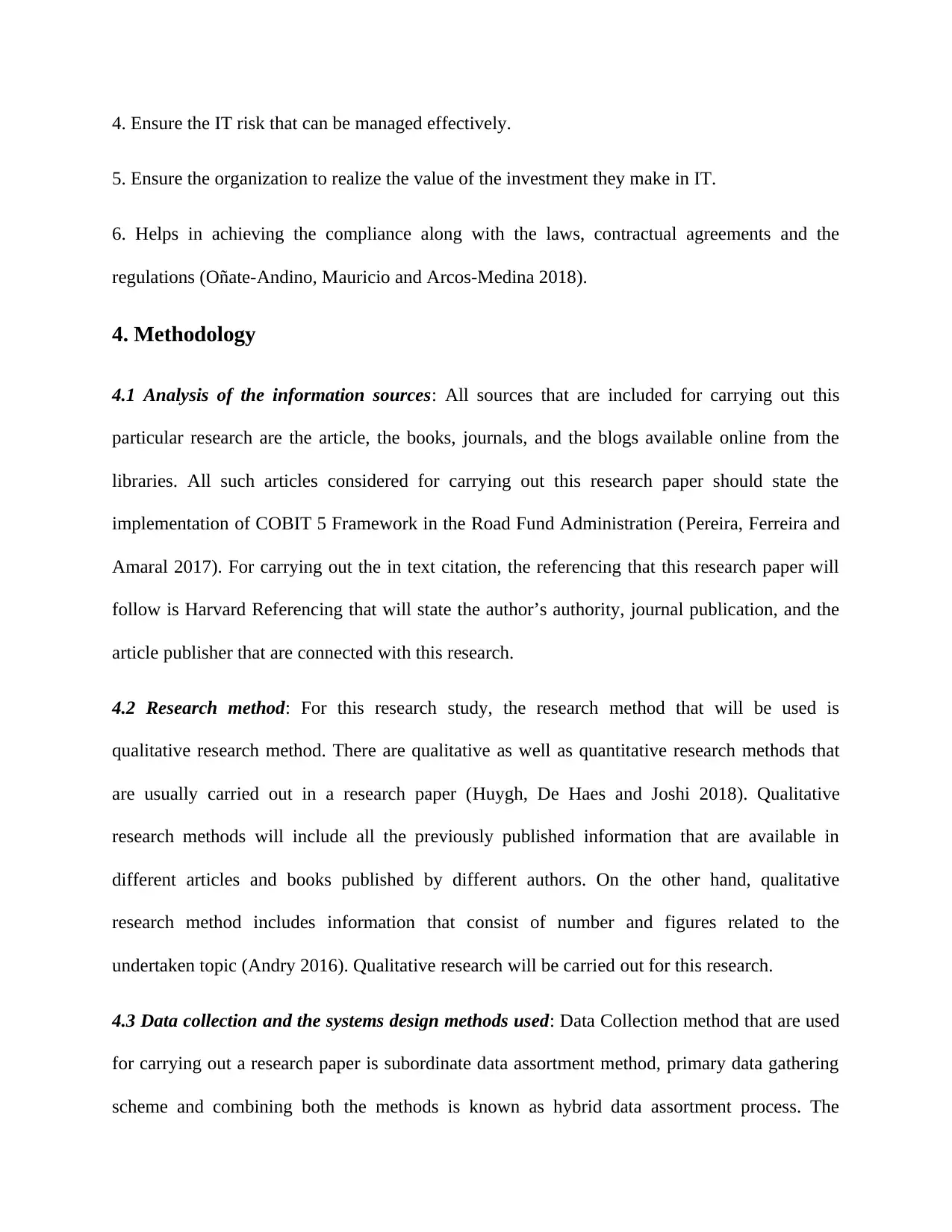
4. Ensure the IT risk that can be managed effectively.
5. Ensure the organization to realize the value of the investment they make in IT.
6. Helps in achieving the compliance along with the laws, contractual agreements and the
regulations (Oñate-Andino, Mauricio and Arcos-Medina 2018).
4. Methodology
4.1 Analysis of the information sources: All sources that are included for carrying out this
particular research are the article, the books, journals, and the blogs available online from the
libraries. All such articles considered for carrying out this research paper should state the
implementation of COBIT 5 Framework in the Road Fund Administration (Pereira, Ferreira and
Amaral 2017). For carrying out the in text citation, the referencing that this research paper will
follow is Harvard Referencing that will state the author’s authority, journal publication, and the
article publisher that are connected with this research.
4.2 Research method: For this research study, the research method that will be used is
qualitative research method. There are qualitative as well as quantitative research methods that
are usually carried out in a research paper (Huygh, De Haes and Joshi 2018). Qualitative
research methods will include all the previously published information that are available in
different articles and books published by different authors. On the other hand, qualitative
research method includes information that consist of number and figures related to the
undertaken topic (Andry 2016). Qualitative research will be carried out for this research.
4.3 Data collection and the systems design methods used: Data Collection method that are used
for carrying out a research paper is subordinate data assortment method, primary data gathering
scheme and combining both the methods is known as hybrid data assortment process. The
5. Ensure the organization to realize the value of the investment they make in IT.
6. Helps in achieving the compliance along with the laws, contractual agreements and the
regulations (Oñate-Andino, Mauricio and Arcos-Medina 2018).
4. Methodology
4.1 Analysis of the information sources: All sources that are included for carrying out this
particular research are the article, the books, journals, and the blogs available online from the
libraries. All such articles considered for carrying out this research paper should state the
implementation of COBIT 5 Framework in the Road Fund Administration (Pereira, Ferreira and
Amaral 2017). For carrying out the in text citation, the referencing that this research paper will
follow is Harvard Referencing that will state the author’s authority, journal publication, and the
article publisher that are connected with this research.
4.2 Research method: For this research study, the research method that will be used is
qualitative research method. There are qualitative as well as quantitative research methods that
are usually carried out in a research paper (Huygh, De Haes and Joshi 2018). Qualitative
research methods will include all the previously published information that are available in
different articles and books published by different authors. On the other hand, qualitative
research method includes information that consist of number and figures related to the
undertaken topic (Andry 2016). Qualitative research will be carried out for this research.
4.3 Data collection and the systems design methods used: Data Collection method that are used
for carrying out a research paper is subordinate data assortment method, primary data gathering
scheme and combining both the methods is known as hybrid data assortment process. The
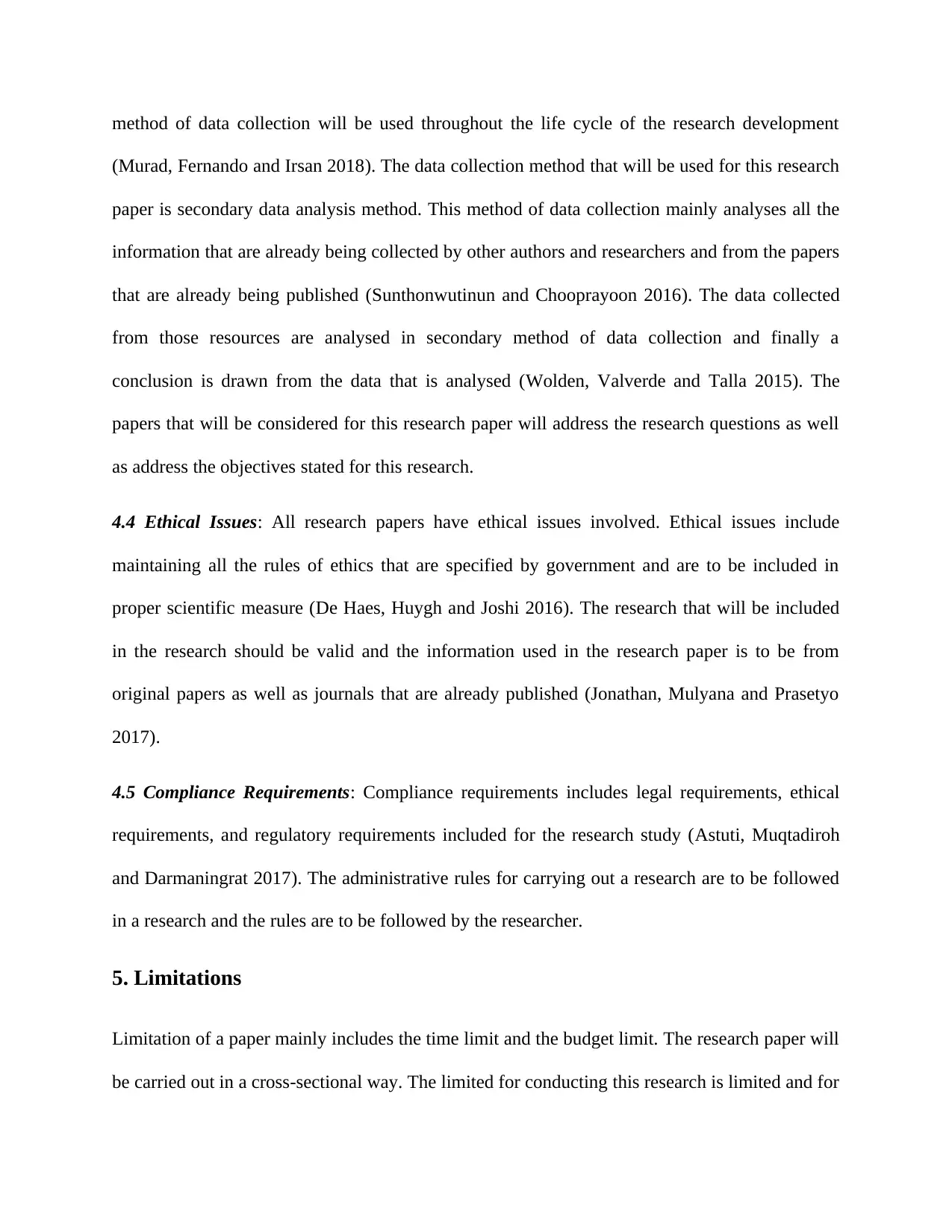
method of data collection will be used throughout the life cycle of the research development
(Murad, Fernando and Irsan 2018). The data collection method that will be used for this research
paper is secondary data analysis method. This method of data collection mainly analyses all the
information that are already being collected by other authors and researchers and from the papers
that are already being published (Sunthonwutinun and Chooprayoon 2016). The data collected
from those resources are analysed in secondary method of data collection and finally a
conclusion is drawn from the data that is analysed (Wolden, Valverde and Talla 2015). The
papers that will be considered for this research paper will address the research questions as well
as address the objectives stated for this research.
4.4 Ethical Issues: All research papers have ethical issues involved. Ethical issues include
maintaining all the rules of ethics that are specified by government and are to be included in
proper scientific measure (De Haes, Huygh and Joshi 2016). The research that will be included
in the research should be valid and the information used in the research paper is to be from
original papers as well as journals that are already published (Jonathan, Mulyana and Prasetyo
2017).
4.5 Compliance Requirements: Compliance requirements includes legal requirements, ethical
requirements, and regulatory requirements included for the research study (Astuti, Muqtadiroh
and Darmaningrat 2017). The administrative rules for carrying out a research are to be followed
in a research and the rules are to be followed by the researcher.
5. Limitations
Limitation of a paper mainly includes the time limit and the budget limit. The research paper will
be carried out in a cross-sectional way. The limited for conducting this research is limited and for
(Murad, Fernando and Irsan 2018). The data collection method that will be used for this research
paper is secondary data analysis method. This method of data collection mainly analyses all the
information that are already being collected by other authors and researchers and from the papers
that are already being published (Sunthonwutinun and Chooprayoon 2016). The data collected
from those resources are analysed in secondary method of data collection and finally a
conclusion is drawn from the data that is analysed (Wolden, Valverde and Talla 2015). The
papers that will be considered for this research paper will address the research questions as well
as address the objectives stated for this research.
4.4 Ethical Issues: All research papers have ethical issues involved. Ethical issues include
maintaining all the rules of ethics that are specified by government and are to be included in
proper scientific measure (De Haes, Huygh and Joshi 2016). The research that will be included
in the research should be valid and the information used in the research paper is to be from
original papers as well as journals that are already published (Jonathan, Mulyana and Prasetyo
2017).
4.5 Compliance Requirements: Compliance requirements includes legal requirements, ethical
requirements, and regulatory requirements included for the research study (Astuti, Muqtadiroh
and Darmaningrat 2017). The administrative rules for carrying out a research are to be followed
in a research and the rules are to be followed by the researcher.
5. Limitations
Limitation of a paper mainly includes the time limit and the budget limit. The research paper will
be carried out in a cross-sectional way. The limited for conducting this research is limited and for
⊘ This is a preview!⊘
Do you want full access?
Subscribe today to unlock all pages.

Trusted by 1+ million students worldwide
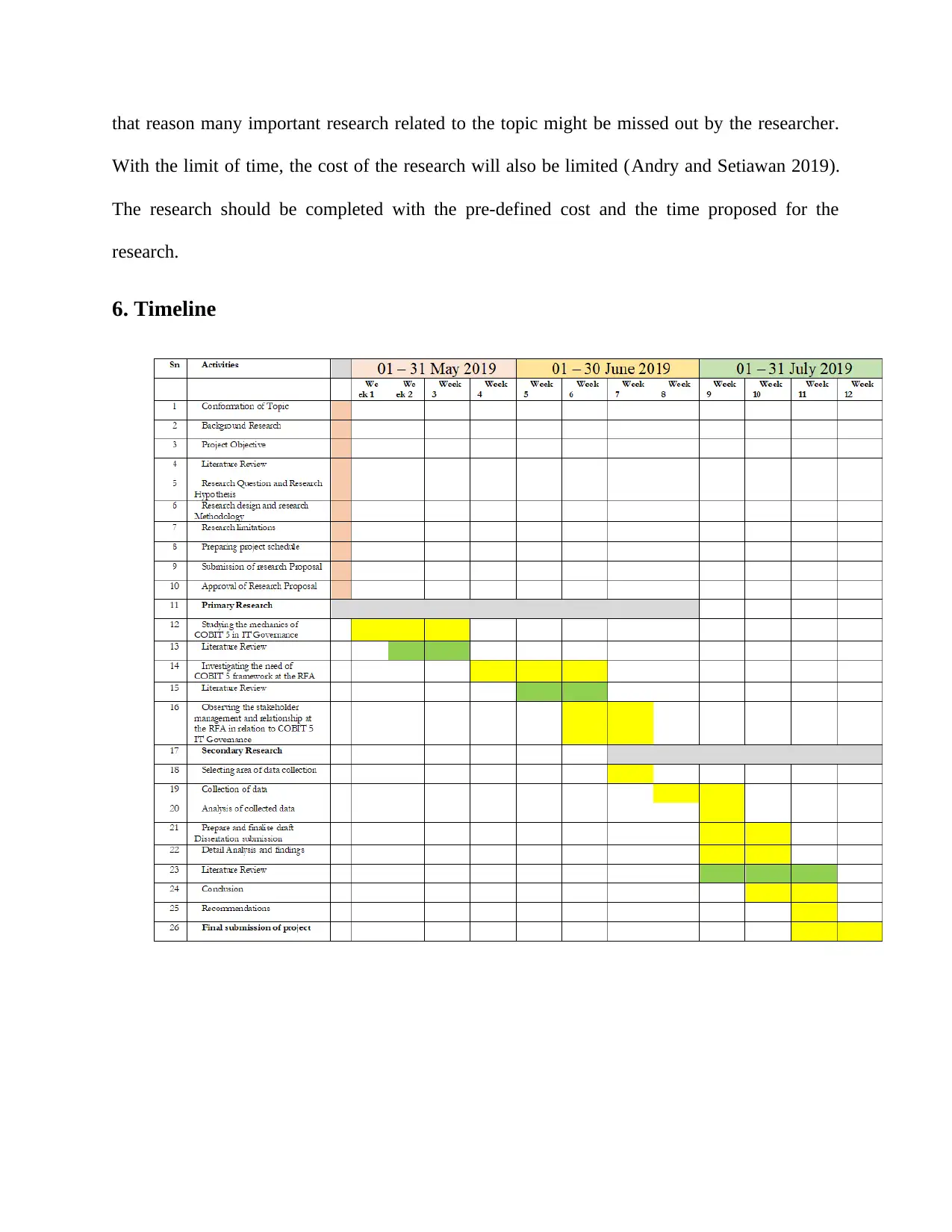
that reason many important research related to the topic might be missed out by the researcher.
With the limit of time, the cost of the research will also be limited (Andry and Setiawan 2019).
The research should be completed with the pre-defined cost and the time proposed for the
research.
6. Timeline
With the limit of time, the cost of the research will also be limited (Andry and Setiawan 2019).
The research should be completed with the pre-defined cost and the time proposed for the
research.
6. Timeline
Paraphrase This Document
Need a fresh take? Get an instant paraphrase of this document with our AI Paraphraser
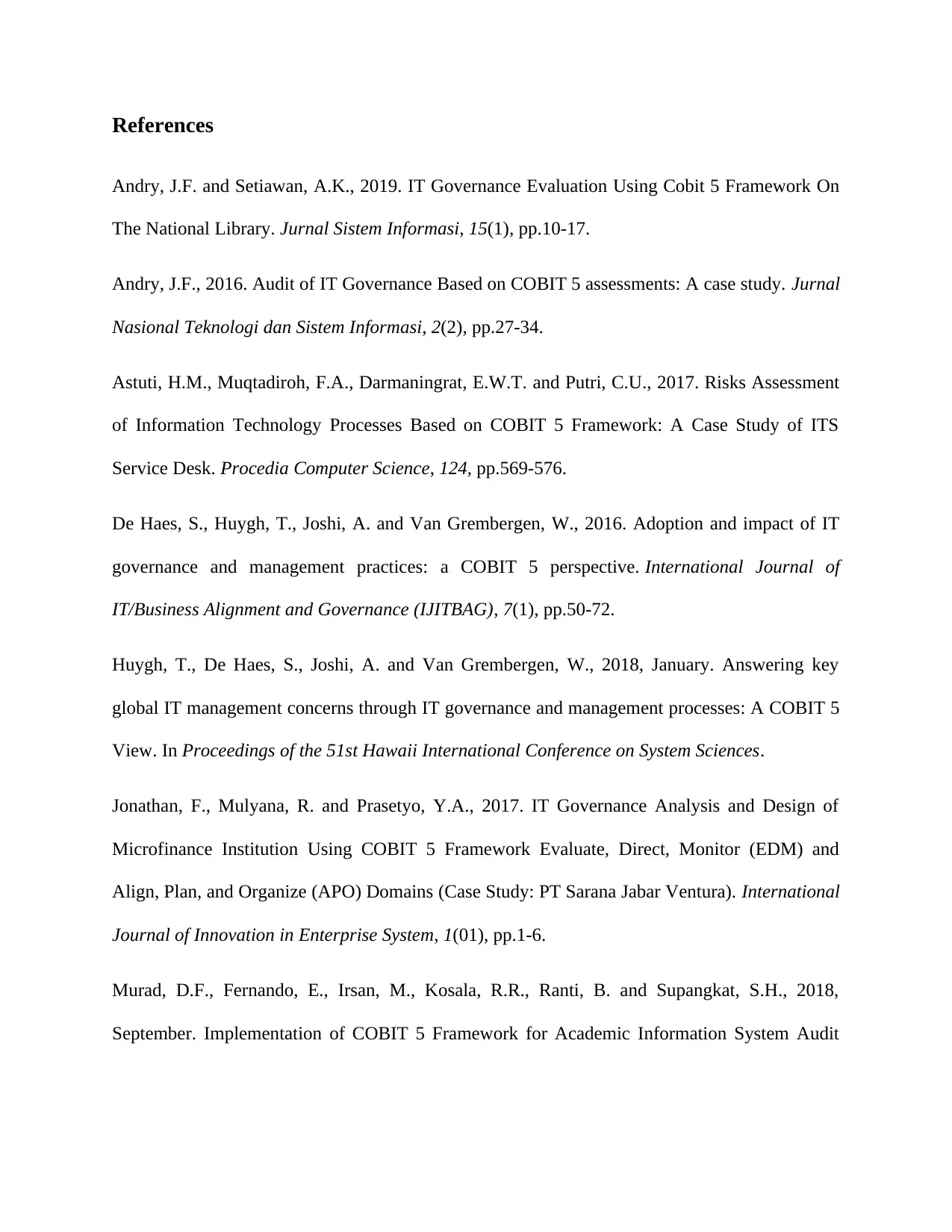
References
Andry, J.F. and Setiawan, A.K., 2019. IT Governance Evaluation Using Cobit 5 Framework On
The National Library. Jurnal Sistem Informasi, 15(1), pp.10-17.
Andry, J.F., 2016. Audit of IT Governance Based on COBIT 5 assessments: A case study. Jurnal
Nasional Teknologi dan Sistem Informasi, 2(2), pp.27-34.
Astuti, H.M., Muqtadiroh, F.A., Darmaningrat, E.W.T. and Putri, C.U., 2017. Risks Assessment
of Information Technology Processes Based on COBIT 5 Framework: A Case Study of ITS
Service Desk. Procedia Computer Science, 124, pp.569-576.
De Haes, S., Huygh, T., Joshi, A. and Van Grembergen, W., 2016. Adoption and impact of IT
governance and management practices: a COBIT 5 perspective. International Journal of
IT/Business Alignment and Governance (IJITBAG), 7(1), pp.50-72.
Huygh, T., De Haes, S., Joshi, A. and Van Grembergen, W., 2018, January. Answering key
global IT management concerns through IT governance and management processes: A COBIT 5
View. In Proceedings of the 51st Hawaii International Conference on System Sciences.
Jonathan, F., Mulyana, R. and Prasetyo, Y.A., 2017. IT Governance Analysis and Design of
Microfinance Institution Using COBIT 5 Framework Evaluate, Direct, Monitor (EDM) and
Align, Plan, and Organize (APO) Domains (Case Study: PT Sarana Jabar Ventura). International
Journal of Innovation in Enterprise System, 1(01), pp.1-6.
Murad, D.F., Fernando, E., Irsan, M., Kosala, R.R., Ranti, B. and Supangkat, S.H., 2018,
September. Implementation of COBIT 5 Framework for Academic Information System Audit
Andry, J.F. and Setiawan, A.K., 2019. IT Governance Evaluation Using Cobit 5 Framework On
The National Library. Jurnal Sistem Informasi, 15(1), pp.10-17.
Andry, J.F., 2016. Audit of IT Governance Based on COBIT 5 assessments: A case study. Jurnal
Nasional Teknologi dan Sistem Informasi, 2(2), pp.27-34.
Astuti, H.M., Muqtadiroh, F.A., Darmaningrat, E.W.T. and Putri, C.U., 2017. Risks Assessment
of Information Technology Processes Based on COBIT 5 Framework: A Case Study of ITS
Service Desk. Procedia Computer Science, 124, pp.569-576.
De Haes, S., Huygh, T., Joshi, A. and Van Grembergen, W., 2016. Adoption and impact of IT
governance and management practices: a COBIT 5 perspective. International Journal of
IT/Business Alignment and Governance (IJITBAG), 7(1), pp.50-72.
Huygh, T., De Haes, S., Joshi, A. and Van Grembergen, W., 2018, January. Answering key
global IT management concerns through IT governance and management processes: A COBIT 5
View. In Proceedings of the 51st Hawaii International Conference on System Sciences.
Jonathan, F., Mulyana, R. and Prasetyo, Y.A., 2017. IT Governance Analysis and Design of
Microfinance Institution Using COBIT 5 Framework Evaluate, Direct, Monitor (EDM) and
Align, Plan, and Organize (APO) Domains (Case Study: PT Sarana Jabar Ventura). International
Journal of Innovation in Enterprise System, 1(01), pp.1-6.
Murad, D.F., Fernando, E., Irsan, M., Kosala, R.R., Ranti, B. and Supangkat, S.H., 2018,
September. Implementation of COBIT 5 Framework for Academic Information System Audit
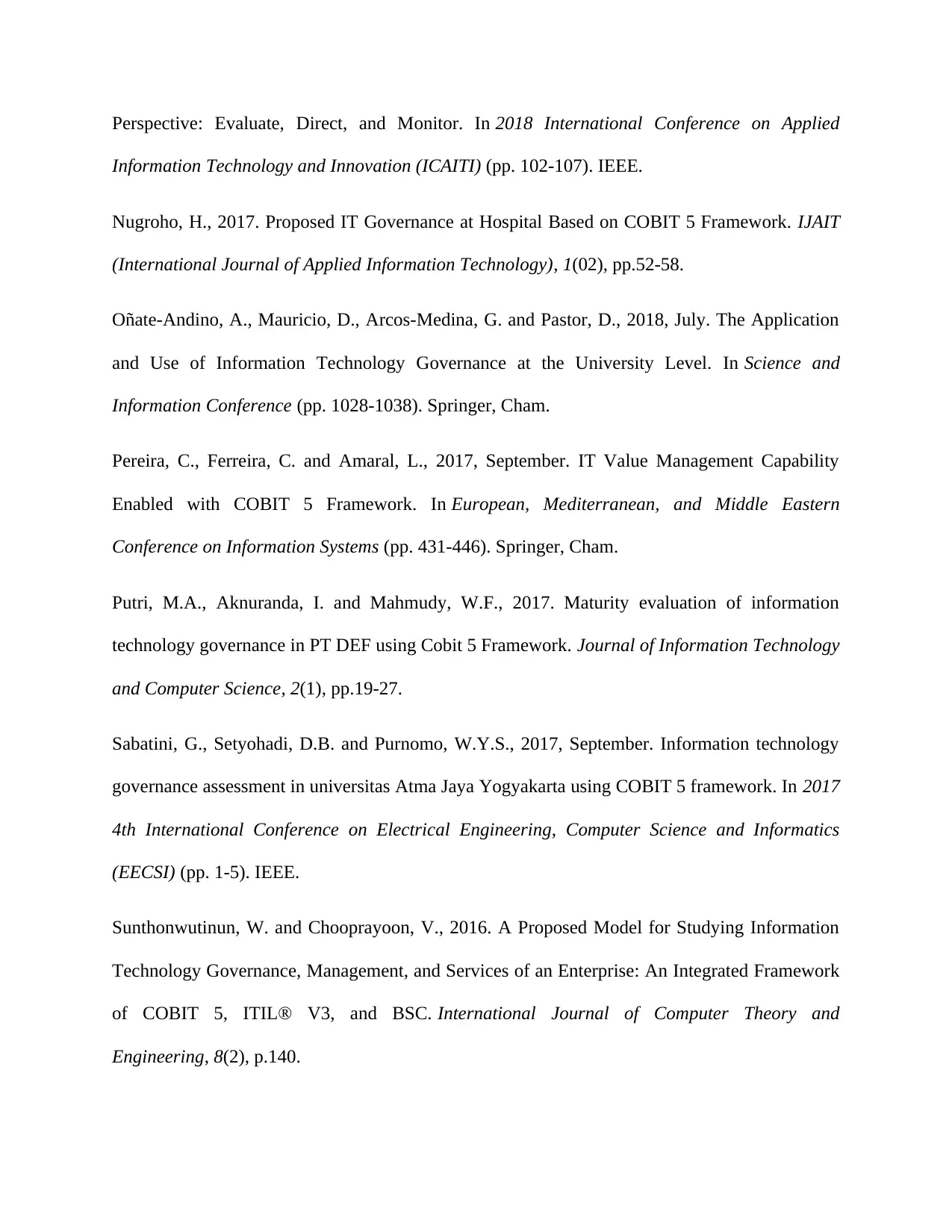
Perspective: Evaluate, Direct, and Monitor. In 2018 International Conference on Applied
Information Technology and Innovation (ICAITI) (pp. 102-107). IEEE.
Nugroho, H., 2017. Proposed IT Governance at Hospital Based on COBIT 5 Framework. IJAIT
(International Journal of Applied Information Technology), 1(02), pp.52-58.
Oñate-Andino, A., Mauricio, D., Arcos-Medina, G. and Pastor, D., 2018, July. The Application
and Use of Information Technology Governance at the University Level. In Science and
Information Conference (pp. 1028-1038). Springer, Cham.
Pereira, C., Ferreira, C. and Amaral, L., 2017, September. IT Value Management Capability
Enabled with COBIT 5 Framework. In European, Mediterranean, and Middle Eastern
Conference on Information Systems (pp. 431-446). Springer, Cham.
Putri, M.A., Aknuranda, I. and Mahmudy, W.F., 2017. Maturity evaluation of information
technology governance in PT DEF using Cobit 5 Framework. Journal of Information Technology
and Computer Science, 2(1), pp.19-27.
Sabatini, G., Setyohadi, D.B. and Purnomo, W.Y.S., 2017, September. Information technology
governance assessment in universitas Atma Jaya Yogyakarta using COBIT 5 framework. In 2017
4th International Conference on Electrical Engineering, Computer Science and Informatics
(EECSI) (pp. 1-5). IEEE.
Sunthonwutinun, W. and Chooprayoon, V., 2016. A Proposed Model for Studying Information
Technology Governance, Management, and Services of an Enterprise: An Integrated Framework
of COBIT 5, ITIL® V3, and BSC. International Journal of Computer Theory and
Engineering, 8(2), p.140.
Information Technology and Innovation (ICAITI) (pp. 102-107). IEEE.
Nugroho, H., 2017. Proposed IT Governance at Hospital Based on COBIT 5 Framework. IJAIT
(International Journal of Applied Information Technology), 1(02), pp.52-58.
Oñate-Andino, A., Mauricio, D., Arcos-Medina, G. and Pastor, D., 2018, July. The Application
and Use of Information Technology Governance at the University Level. In Science and
Information Conference (pp. 1028-1038). Springer, Cham.
Pereira, C., Ferreira, C. and Amaral, L., 2017, September. IT Value Management Capability
Enabled with COBIT 5 Framework. In European, Mediterranean, and Middle Eastern
Conference on Information Systems (pp. 431-446). Springer, Cham.
Putri, M.A., Aknuranda, I. and Mahmudy, W.F., 2017. Maturity evaluation of information
technology governance in PT DEF using Cobit 5 Framework. Journal of Information Technology
and Computer Science, 2(1), pp.19-27.
Sabatini, G., Setyohadi, D.B. and Purnomo, W.Y.S., 2017, September. Information technology
governance assessment in universitas Atma Jaya Yogyakarta using COBIT 5 framework. In 2017
4th International Conference on Electrical Engineering, Computer Science and Informatics
(EECSI) (pp. 1-5). IEEE.
Sunthonwutinun, W. and Chooprayoon, V., 2016. A Proposed Model for Studying Information
Technology Governance, Management, and Services of an Enterprise: An Integrated Framework
of COBIT 5, ITIL® V3, and BSC. International Journal of Computer Theory and
Engineering, 8(2), p.140.
⊘ This is a preview!⊘
Do you want full access?
Subscribe today to unlock all pages.

Trusted by 1+ million students worldwide
1 out of 13
Your All-in-One AI-Powered Toolkit for Academic Success.
+13062052269
info@desklib.com
Available 24*7 on WhatsApp / Email
![[object Object]](/_next/static/media/star-bottom.7253800d.svg)
Unlock your academic potential
Copyright © 2020–2025 A2Z Services. All Rights Reserved. Developed and managed by ZUCOL.


